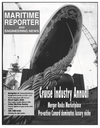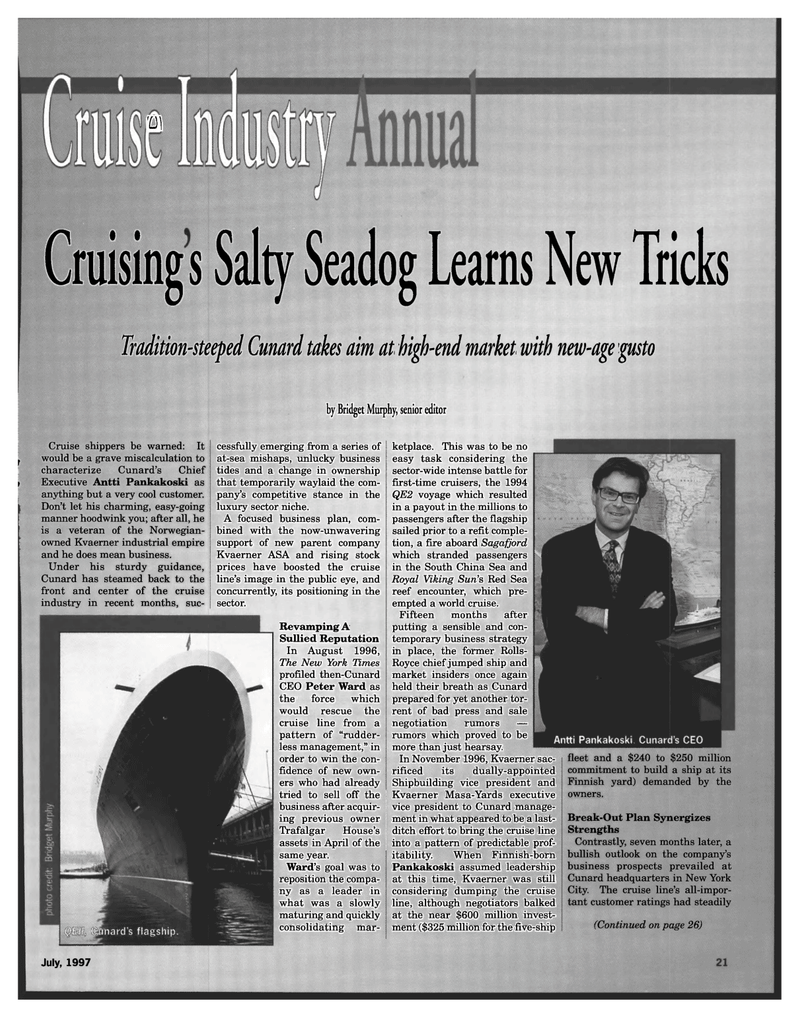
Page 21: of Maritime Reporter Magazine (July 1997)
Read this page in Pdf, Flash or Html5 edition of July 1997 Maritime Reporter Magazine
Cruising s Salty Seadog Learns New Tricks
Tradition-steeped Cunard takes aim at high-end market with new-age gusto m by Bridget Murphy, senior editor
July, 1997 23
Cruise shippers be warned: It f would be a grave miscalculation to characterize Cunard's Chief > Executive Antti Pankakoski as anything but a very cool customer.
Don't let his charming, easy-going manner hoodwink you; after all, he is a veteran of the Norwegian- owned Kvaerner industrial empire and he does mean business.
Under his sturdy guidance,
Cunard has steamed back to the front and center of the cruise industry in recent months, suc- cessfully emerging from a series of at-sea mishaps, unlucky business tides and a change in ownership that temporarily waylaid the com- pany's competitive stance in the luxury sector niche.
A focused business plan, com- bined with the now-unwavering support of new parent company
Kvaerner ASA and rising stock prices have boosted the cruise line's image in the public eye, and concurrently, its positioning in the sector.
Revamping A
Sullied Reputation
In August 1996,
The New York Times profiled then-Cunard
CEO Peter Ward as the force which would rescue the cruise line from a pattern of "rudder- less management," in order to win the con- fidence of new own- ers who had already tried to sell off the business after acquir- ing previous owner
Trafalgar House's assets in April of the same year.
Ward's goal was to reposition the compa- ny as a leader in what was a slowly maturing and quickly consolidating mar- ketplace. This was to be no easy task considering the sector-wide intense battle for first-time cruisers, the 1994
QE2 voyage which resulted in a payout in the millions to passengers after the flagship sailed prior to a refit comple- tion, a fire aboard Sagafjord which stranded passengers in the South China Sea and
Royal Viking Sun's Red Sea reef encounter, which pre- empted a world cruise.
Fifteen months after putting a sensible and con- temporary business strategy in place, the former Rolls-
Royce chief jumped ship and market insiders once again held their breath as Cunard prepared for yet another tor- rent of bad press and sale negotiation rumors — rumors which proved to be more than just hearsay.
In November 1996, Kvaerner sac- rificed its dually-appointed
Shipbuilding vice president and
Kvaerner Masa-Yards executive vice president to Cunard manage- ment in what appeared to be a last- ditch effort to bring the cruise line into a pattern of predictable prof- itability. When Finnish-born
Pankakoski assumed leadership at this time, Kvaerner was still considering dumping the cruise line, although negotiators balked at the near $600 million invest- ment ($325 million for the five-ship fleet and a $240 to $250 million commitment to build a ship at its
Finnish yard) demanded by the owners.
Break-Out Plan Synergizes
Strengths
Contrastly, seven months later, a bullish outlook on the company's business prospects prevailed at
Cunard headquarters in New York
City. The cruise line's all-impor- tant customer ratings had steadily (Continued on page 26)

 20
20

 22
22
